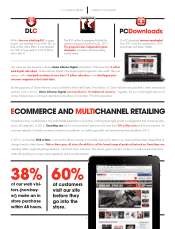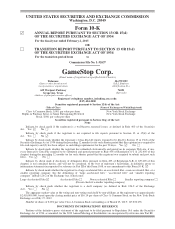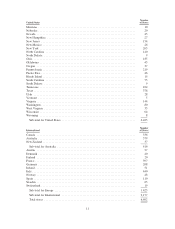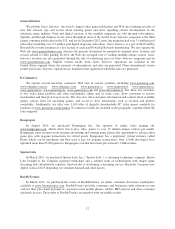GameStop 2012 Annual Report Download - page 19
Download and view the complete annual report
Please find page 19 of the 2012 GameStop annual report below. You can navigate through the pages in the report by either clicking on the pages listed below, or by using the keyword search tool below to find specific information within the annual report.New Video Game Products. The Entertainment Software Association (“ESA”) estimates that the average
U.S. household owns at least one dedicated game console, PC or smartphone. Additionally, 49% of
U.S. households own on average two dedicated game consoles. We expect the following trends in sales of video
game products:
•Video Game Hardware. Gaming consoles are typically launched in cycles as technological
developments in both chip processing speeds and data storage provide significant improvements in
advanced graphics, audio quality and other entertainment capabilities beyond video gaming. The current
generation of consoles includes the Sony PlayStation 3, the Nintendo Wii and Microsoft Xbox 360, which
all launched between 2005 and 2007. These console technologies have evolved considerably through
several generations since the introduction of video game consoles in the 1980s. The typical cycle for
hardware consoles lasts approximately five years and during each cycle it is typical for the price of the
hardware consoles to decline over time. This cycle of consoles is longer than previous cycles and as a
result sales have declined in recent years. A new console cycle is developing as Nintendo launched the
Wii U in November 2012 as the next generation of the Wii. Also, Sony has announced that the next
generation of the PlayStation will come to market by the holiday period of 2013. Microsoft has not yet
formally announced definitive plans to introduce a new console. The Company expects that demand for
current generation hardware will continue to decline in anticipation of the next generation of consoles
becoming available in the market.
In addition, portable handheld video game devices have evolved to the Nintendo 3DS, which was
introduced in March 2011, and the Sony PlayStation Vita, which was introduced in February 2012. The
market for handheld devices has declined in recent years as the proliferation of smart phones and other
mobile devices and digitally downloadable mobile video games offer video game players alternative ways
to play games.
•Video Game Software. Sales of video game software generally increase as gaming platforms mature and
gain wider acceptance. Sales of video game software are dependent upon manufacturers and third-party
publishers developing and releasing game titles for existing game platforms. In recent years the number
of new games introduced each year has declined and the market for video game sales has also declined
each year. This trend is expected to continue until new consoles are introduced.
Pre-owned Video Game Products. As the installed base of video game hardware platforms has increased
and new hardware platforms are introduced, a considerable market for pre-owned video game hardware and
software has developed. Based on reports published by the NPD Group, we believe that, as of December 2012,
the installed base of video game hardware systems in the United States, based on original sales, totaled over
294 million units of handheld and console video game systems and grew by 19 million units in 2012. According
to IDG, the installed base of hardware systems as of December 2012 in Europe was approximately 187 million
units and grew by 14 million units in 2012. Hardware manufacturers and third-party software publishers have
produced a wide variety of software titles for each of these hardware platforms. Based on internal Company
estimates, we believe that the installed base of video game software units in the United States currently exceeds
2.3 billion units. As the substantial installed base of video game hardware and software continues to expand,
there is ongoing demand for pre-owned video game products.
PC Entertainment Software. PC entertainment software is generally played on PCs featuring fast
processors, expanded memories, and enhanced graphics and audio capabilities. Trends in sales of PC
entertainment software are largely dependent upon introductions of hit titles, which are typically limited to one or
two per year.
Casual Games. The casual game market consists primarily of digital games and has grown rapidly over
the last few years. Casual games are generally defined as simple, easy-to-use, free or very low-priced games
played through the internet in Web browsers, on dedicated gaming Web sites or on mobile phones or other
mobile devices. Casual games cost less to develop and distribute than a traditional console video game and are
often supported by in-game advertising or user-purchased premium content. The typical casual gamer is
predominantly female and older than a traditional console video game player.
4
























